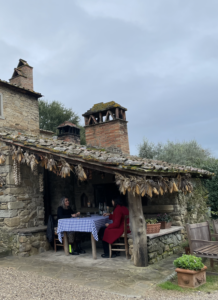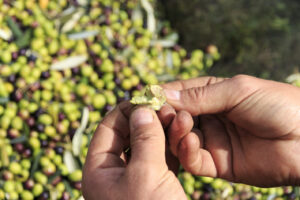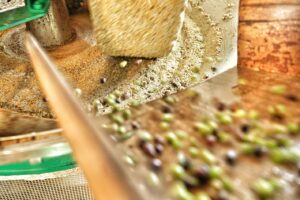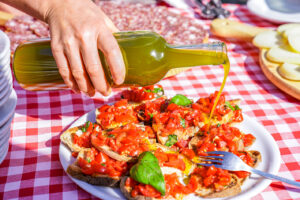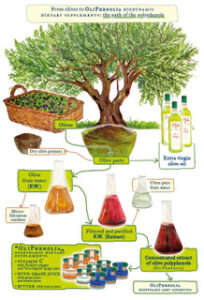Polyphenols – Longevity aus Pflanzen
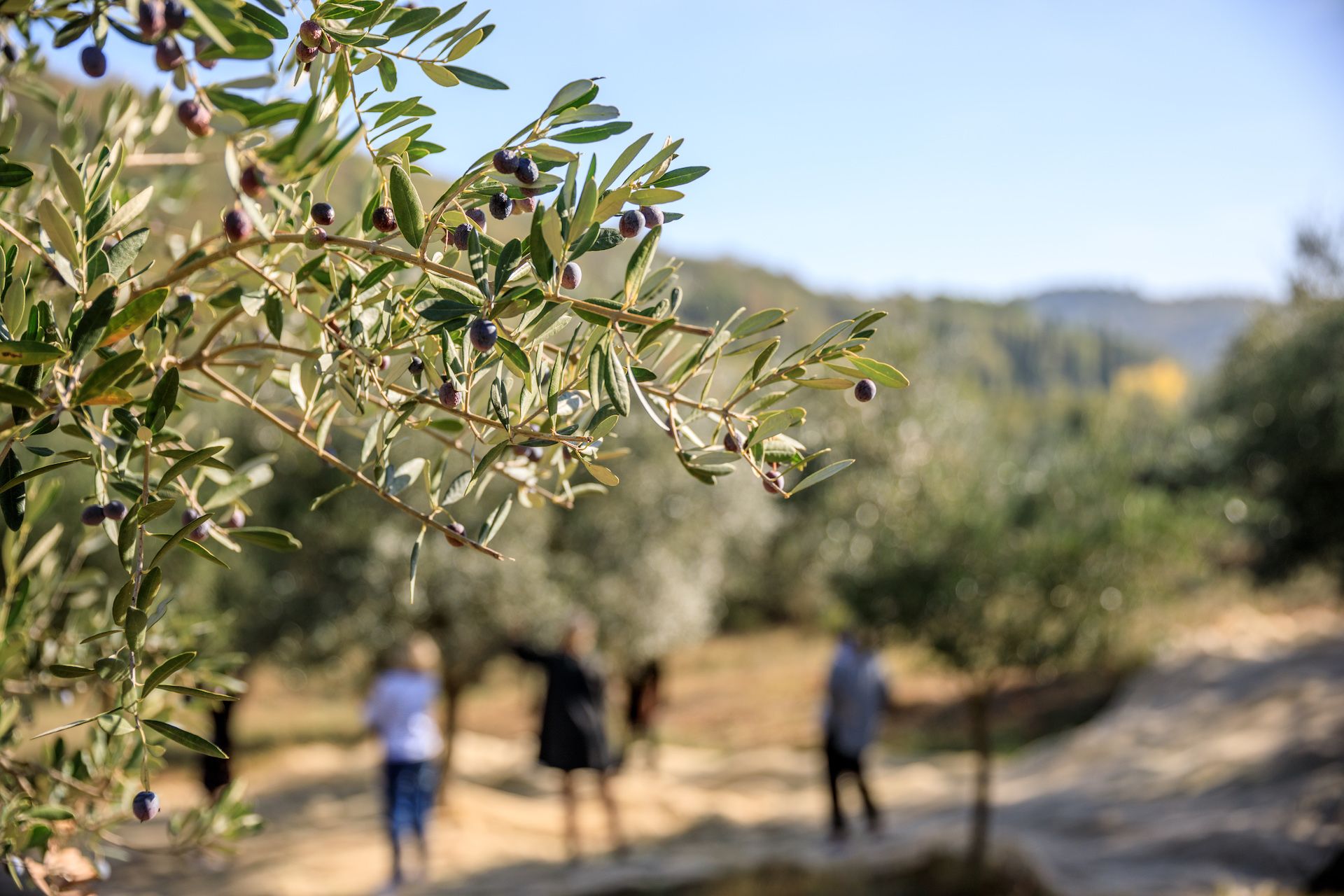
Polyphenols are essential for the survival of plants. But they can also provide important services to human health. Milan-based scientist Prof. Adriana Albini has made an astonishing discovery in olive press water.
Polyphenols are found in almost every fruit and vegetable, in herbs and also in some foods known as superfoods, such as cocoa powder, chokeberries and blueberries. These so-called secondary metabolites primarily have an antioxidant effect. Many compounds serve as defense substances against pests, diseases and much more. Colorful flower pigments are also plant phenols and attract insects for pollination, for example. However, polyphenols are mainly found in the outer layers of plants (e.g. the skin and the peel).
And this is where olives come into play. The dark water obtained during pressing contains an enormous amount of highly effective polyphenols. It is actually a waste product, as we mainly appreciate the oil obtained in the process. This is not the case at Fattoria La Vialla in Meliciano, Tuscany. There, the olive press water is not disposed of, but filled into small jars and sold as a dietary supplement.
The tradition of “acqua mora” in Italy is a long one. The ancients have always drunk the bitter elixir of longevity. Nonna Caterina, the great-grandmother of the Lo Francos, is said to have drunk two glasses of it a day during the olive harvest – and lived to be 98 years old.
Polyphenols from a scientific point of view
Dr. Adriana Albini, who works at the European Institute of Oncology – IEO in Milan and mainly researches inflammatory processes in the body and cancer prevention, examined the OliPhenolia from the Fattoria in more detail.
When and how did you come into contact with OliPhenolia?
Ah, that’s a nice story. It happened a few years ago. I was speaking on an Italian television program about dietary derivatives for health. The Lo Franco family, owners of Fattoria La Vialla, were watching and asked me if I would be interested in investigating their product, which was obtained from the filtration of “waste water” from olive flour. This olive press water is very rich in healthy substances, especially polyphenols. So I agreed to research it scientifically. We then started to purify the extract and test it on cells in the laboratory.
Had you ever heard of “acqua mora” before?
Not directly. But it has long been known that olive oil has a positive effect on the human organism. And there are many studies that show that the use of olive oil in the diet is linked to longevity, better health and disease prevention.
There is also a very old tradition of recovering waste products. My sister is a philosopher and has studied ancient Greece. Together we searched archives and studies for something similar to “acqua mora”. It was called amurca, the Latin name for the bitter-tasting, dark-colored, watery sediment that settles over time in unfiltered olive oil. It was already used for therapeutic purposes at that time.
What particularly sparked your interest in this research?
Well, my field has always been inflammation, inflammatory diseases, cardiovascular diseases, metabolic syndrome and, of course, cancer. Especially cancer prevention. And I have studied various polyphenols in important journals such as Nature Medicine and others. For example, polyphenols from green tea or beer hops. Xanthohumol, the polyphenol from hops, was found to have cancer-preventive potential in in-vitro tests. But I also examined apples, various foods and spices. So that was part of my research tradition.
I got stuck on the studies with olive oil because it is one of the most powerful products. Mainly because it is a complex of many different phytochemicals and very rich in important polyphenols such as hydroxytyrosol and oleuropein, in addition to the polyunsaturated omega-3 fatty acids. It is therefore a particularly interesting nutraceutical.
What are the benefits of polyphenols in olives compared to other substances?
Polyphenols are a very large class of compounds. And there are so many different side chains of organic material. The attraction is that with other substances like beer or tea, you can only consume a limited amount. Since olive oil is very rich in polyphenols, a tablespoon a day is considered good. And the water content makes it drinkable. So it can be much more concentrated. Therefore, it is definitely superior to many others, and can also be used by taking it orally. You don’t have to take pills. And because it’s derived from a food product, it’s sustainable and also non-toxic because we eat olives.
Why does OliPhenolia taste so bitter?
The fact that it is not sweet is a health benefit. We conducted a study on volunteers with incipient metabolic syndrome. There was very strong evidence that it can be good for lowering cholesterol and blood sugar levels because it’s a non-sugary polyphenol-rich substance. And there are ways to make OliPhenolia less bitter, which is also used, e.g. with grape juice.
Longevity is the issue at the moment. Can polyphenols help?
Well, the study, we have just published is publicly available. It was done in collaboration with a group in Palermo that specializes in aging, particularly healthy aging and longevity. We believe that consuming olive oil products can extend lifespan, and that cells, and therefore people, live healthier.
What exactly happens to the cells?
We have tested it primarily in cancer prevention. In this case, the growth of cancer cells can be curbed. On the other hand, it increases the growth of healthy epithelial cells, for example. In fact, it can be used for cosmetic skin and hair products. It is therefore a very interesting substance that can select which cell should be killed and which should be preserved so that it lives longer.
And the Mediterranean diet, which includes vegetables, fruit, olive oil and spices, can prevent a lot of cancer. Up to 30 percent. Polyphenols have an anti-inflammatory effect and are antioxidants. Oxidation by free radicals is one of the phenomena that causes us to age and also stimulates the growth of cancer cells. Anything that is an antioxidant can therefore prevent both ageing and the development of cancer.
Could an OliPhenolia-like substance also be produced in the laboratory? Or do we need nature for this?
Individual polyphenols can be isolated and purified. And indeed, there are many medicines or over-the-counter products that contain purified polyphenols. But I think the best thing is nature. What’s interesting is that every year the polyphenol content in olives changes slightly. At OliPhenolia, it is measured for each individual variety used to make the essence
In our studies, we have seen that the amount of hydroxytyrosol, oleuropein and verbascoside is similar from one batch to another. But there is always a small difference. The olive oil is a little different every year, just like the wine is different every year. And I think this difference is physiological. And it provides a better matrix for treatment and consumption than a pure or synthetic molecule can.
Can OliPhenolia or polyphenols be overdosed?
Everything can be overdosed. In my opinion, it’s best to use the minimum amount that is effective, because even if a food is good for your health, like broccoli, you can’t eat two kilos of it. Everything has to be in balance. It’s the intelligent combination that counts. So you can’t just eat hamburgers and then try to compensate with OliPhenolia. I really believe that the philosophy of the Mediterranean diet and complementary medicine through nutrition is that we create a balance of different components.
The diversity is also what helps the different cells, because our body is made up of so many different cells. That’s why we scientists also find that the original matrix like an apple is better than quercetin as a substance, or green tea is better than epigallocatechin gallate. The complex of the element is beneficial.
Of course, you have to be sure that there are no toxic substances. The good thing about organic farming is that there are no pesticides or elements that can be toxic. So if we are doing something that has to do with health through nutrition, it is obvious that the origin and treatment of the food should also be known.
Is there a recommendation for the dose of polyphenols?
Yes, there are dosages. They are different in the various recommendations. For example, in the OliPhenolia study conducted with our collaborators from the University of Palermo, 25 ml of OliPhenolia is recommended twice a day – before lunch and before dinner.
This has proven to be safe. There were no toxic effects for 30 days with two glasses every day. The interesting thing about the study, where I evaluated every single parameter, was that 30 days after stopping, the health benefits were still there. For me as a scientist, it would be nice if you could offer some kind of wellness protocol where people combine the OliPhenolia cycle with, for example, walking, healthy eating and other things to do physical and mental activity and maybe wellness.
Why is it important to take it before eating?
Because then the integration in our body is better. It is not diluted with other things. As OliPhenolia is generally not toxic to the stomach, it is distributed naturally in the body. Our idea was to test it before lunch or dinner and not later. Also because it is bitter, it is more pleasant to have a meal afterwards.
It is also important that we carried out studies using mass spectrometry on the metabolomics of humans. We found that metabolites (degradation products of metabolic processes) in particular were affected. And one thing that was also particularly interesting is that the vitamin D effect is increased. This may be interesting not only for longevity, but also for bone health. Although vitamin D is not contained in OliPhenolia, it increases its absorption in the body.
Do polyphenols also have an anti-ageing effect on the skin?
Yes, because they also work against oxidation here. This reduces premature ageing of the epithelial cells. We are now conducting studies on skin cells. Other scientists have also investigated this. We know that olive oil has a healing effect, because even in ancient times it was said that if you had a wound, you should apply a little oil. Olive oil helps because it disinfects, has an antibacterial effect and promotes wound healing.
As far as the skin is concerned, we know that the main factor for ageing and also for the development of cancer is UV light from the sun. This is particularly true for people from northern Europe, who have lighter skin, a kind of risk factor. An interesting aspect of OliPhenolia (i.e. concentrated olive water) is its use in the cosmetics line, for example to prevent the skin from reacting to oxidation after sun exposure.
What effect does OliPhenolia have on obesity?
At the very least, our studies show that it reduces the body mass index, which is related to weight. At the same time, it also seems to help against sarcopenia (loss of muscle strength with age). So we reduce the fat percentage and increase the muscle percentage. This is something that we will work out in more detail. It’s part of studies that have not yet been published. And if you use that, it seems to increase your metabolism, so of course you can lose weight with it. It should definitely be combined with physical activity, such as walking.

CultureAndCream Author from Munich
To travel during my profession as a beauty journalist was never enough for my. Also my six month on a world trip didn’t do it. It always attracts me to other cities, foreign countries, on roadtrips and places I don’t know yet. But I am not only interested in “culture” and “cream”, I am also fascinated by people who have stories to tell . Such unique experiences I want to share with you.
